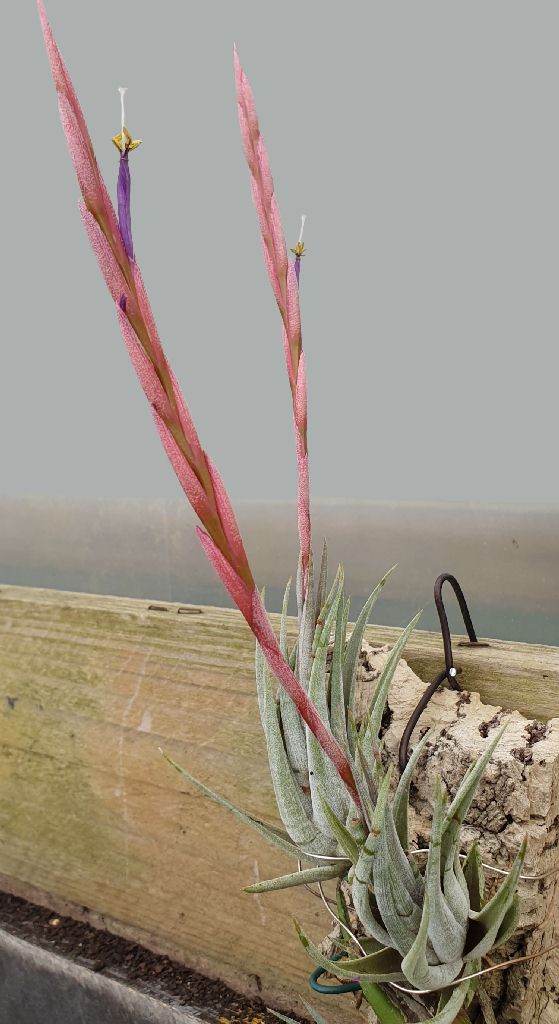
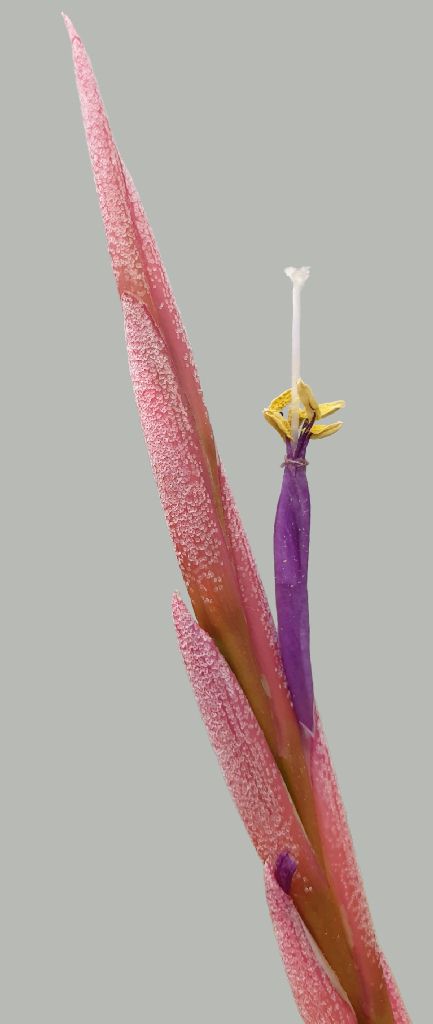
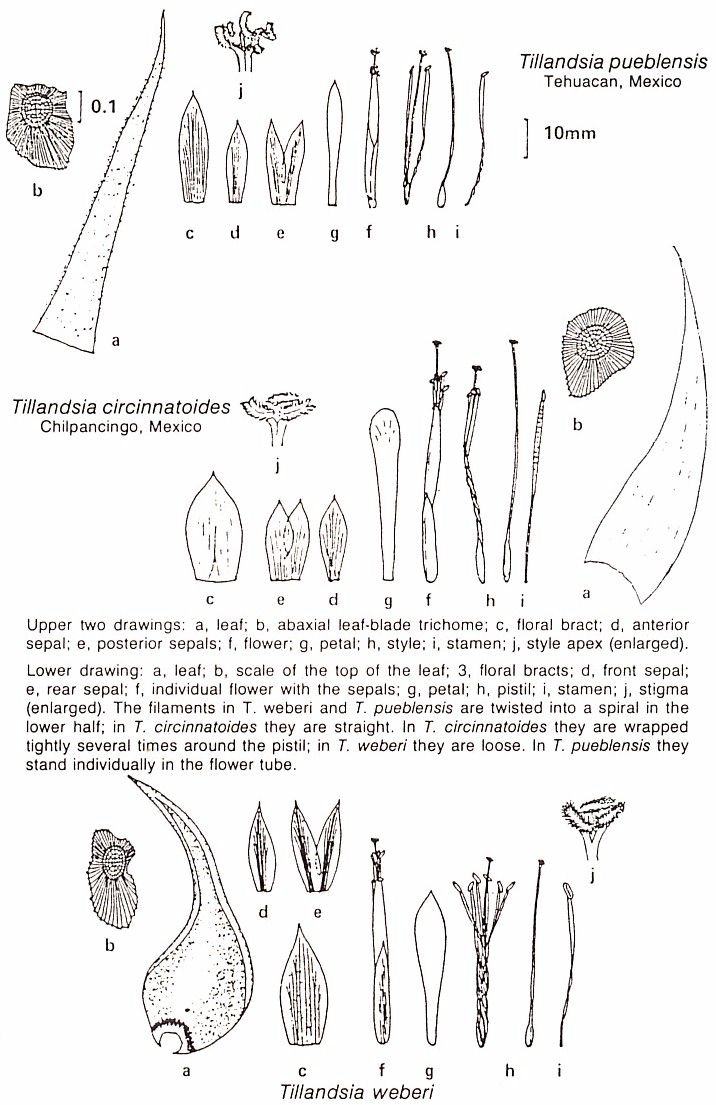
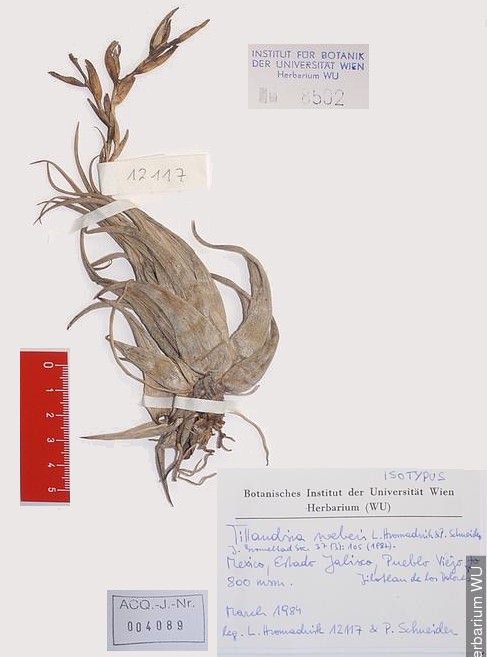
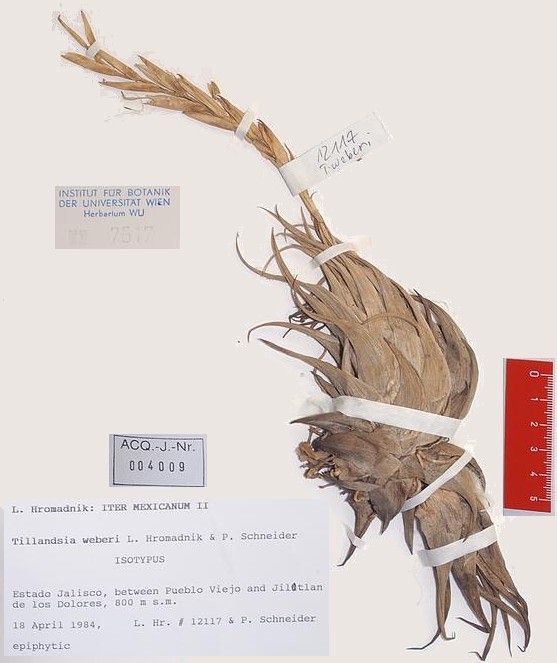
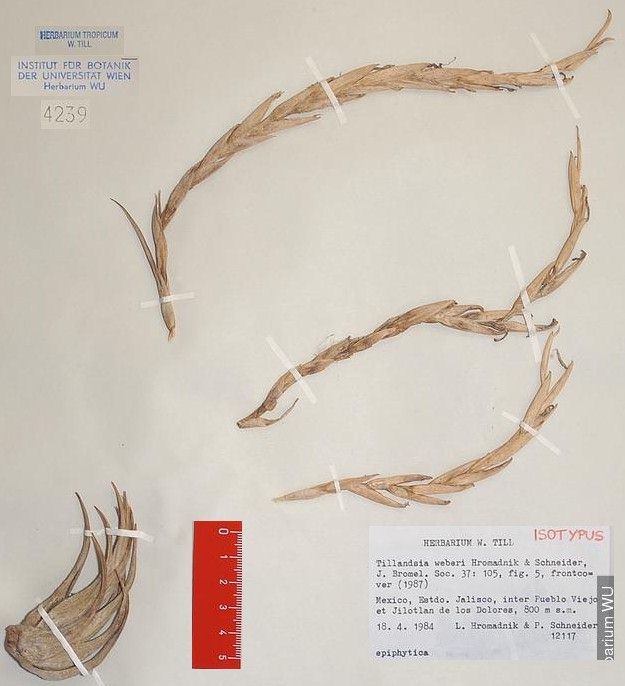
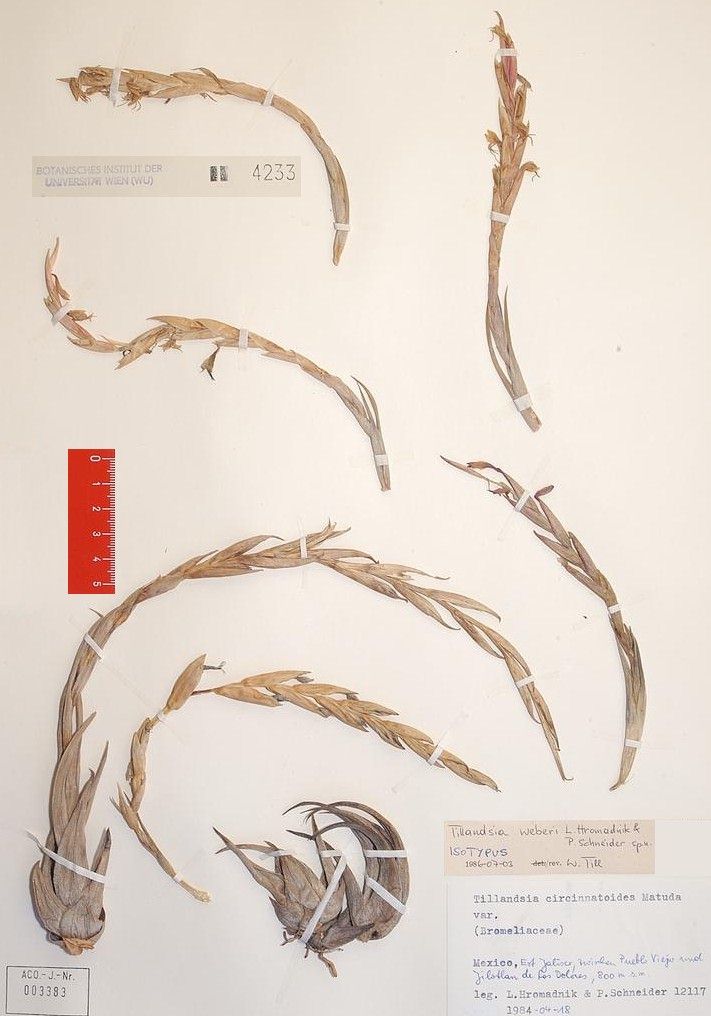
A Tillandsia circinnatoides Matuda, cui affinis, foliis minus nervatis indumento argenteo, habitu minore, inflorescentia longiora, angustiora, bracteis florigeris ecarinatis, minus lepidotis, sepalis brevioribus, glabris, postico 4 mm connatis, petalis latioribus, acuminatis differt; a T. pueblensis L.B. Smith foliis crassioribus, rigidis, brevioribus, subbulbosis, vaginis foliorum magnis, inflorescentia multo longiora et breviora, floribus dense imbricatis, rhachide stricta et bracteibus floralibus obtecta, bracteis floralibus brevioribus et multo latioribus, ovale acuminatis, introrse glabris, floribus sessilibus longioribusque et sepalis minus connatis differt.
Habitat: Mexico, Estado Jalisco, inter Pueblo Viejo et Jilotlan de los Dolores, 800 msm, epiphytica in populatio magna, associata cum Tillandsia recurvata (Linnaeus) L., T. makoyana Baker. T. aff. fasciculata Swartz petalis viridibus (!), T. schiedeana Steudel var. schiedeana C.S. Gardner, Oncidium cf. cebolleta Lindley et Mammillaria sp.
Holotypus: leg. L. Hromadnik & P. Schneider 12117, 18.4.1984 (JE!); Isotypus (WU !).
Plant stemless, single or in small clusters, epiphytic, up to 30 cm long when flowering.
Leaves few, up to 10 cm long, succulent, rigid, hard, and pungent, velvety white lepidote with distinct, fine, parallel, longitudinal nerving, usually turning to one side, forming a loose pseudobulb almost closed at the top;
Sheaths large, oval, spoon-shaped, merging evenly into the blade, 30 mm long, 27 mm at the widest point; on the outside like the blades, but on the inside brownish and very densely covered with adpressed scales; glabrous at the base about 3 mm high, thereafter a more or less distinct violet band about 2 mm wide;
Blades upright to secund, narrowly triangular, 18 to 20 mm wide at the base, the edges quite involute so that the leaves appear subulate at the tip, up to 8 cm long, distinctly nerved, densely pruinose-lepidote with cinereous scales.
Inflorescence scape ascending, arched, up to 15 cm long, 3 mm thick, glabrous, bright salmon red, completely covered by the scape bracts,
Scape bracts basal ones are subfoliate, green, the upper ones dark pink, membranaceous, nerved, densely scaled, acuminate-carinate at the tip, ca. 27 mm long, 10 mm wide at the base and there surrounding the scape; internode length 7 mm.
Inflorescence simple, rarely with 2 spikes, spikes longitudinally lanceolate, complanate, up to 14 cm long, 6 to 8 mm wide, 10 to 15 flowers, internodes 9 mm apart, the straight rachis completely covered by the densely imbricate floral bracts;
Floral bracts longitudinally oval, acute, nerved, lepidote beneath, becoming glabrous, coriaceous, with a membranaceous, somewhat wavy, glabrous, smooth margin, 25 to 30 mm long, 9 mm wide, ecarinate, pink, exceeding the sepals.
Flowers sessile, up to 50 mm long;
Sepals acute lanceolate, 20 mm long, 5 mm wide, whitish green with reddish tips and keels, thinly membranaceous, slightly nerved, glabrous, the posterior connate for 3 to 4 mm high and the keels clearly thickened;
Petals erect, 40 mm long, forming a narrow tube, up to 3 mm wide in the lower part, white, the upper half blue-violet, broadened to 7 mm, with a distinct tip, the latter narrowly rolled back.
Stamens and pistil projecting from the flower tube (subgenus Tillandsia);
filaments up to 45 mm long, ribbon shaped, broadened in the upper third, blue-violet, otherwise white, thin, spirally twisted in the lower half around the longitudinal axis, and altogether loosely wrapped around the style;
anthers yellow, 3 mm long, 1.5 mm wide.
Pistil 50 mm long, exceeding the stamens;
ovary 6 mm long, 2mm wide, whitish green;
style 42 mm long, filiform, white;
stigma white (the stigma type can be attributed most easily to Type I of the system according to A. Gilmartin and G. Brown (1984); however, the three narrow, distinctly elongated stigmatic lobes are individually spiral).
Holotype: L. Hromadnik & P. Schneider 10117 (holotype JE!, isotype WU!), between Pueblo Viejo and Jilotlan de los Dolores, 800 msm, Jalisco, Mexico, 18 April 1984.
Habitat and distribution: The species is known up to this time only from the type locality. It grows there as an epiphyte in a great population on thorn bushes and in low, dry forests along with T. recurvata (Linnaeus) L., T. makoyana Baker, a beautiful, green-flowered T. aff. fasciculata Swartz with reddish leaves. T. schiedeana Steudel var. schiedeana C.S. Gardner, Oncidium cf. cebolleta, and a Mammilaria species.
Our plant is very similar to T. circinnatoides Matuda in its vegetative state. The tight bulb shape is similar. The nerving of the leaf blades, however, is less, the cinereous scaling is more distinct, the leaves are mostly secund and shorter, the plant, in general, is smaller. The inflorescence is distinctly different from T. circinnatoides, where the inflorescence is commonly surpassed by the leaves. The average ratio of plant length to length of the inflorescence in T. circinnatoides is 1:1.2; in T. weberi it is 1:3. Also, the inflorescence in our plant is considerably narrower (8 mm compared to 20 mm). Further differences are in the ecarinate, less distinctly nerved and slightly scaled flower bracts and in the smaller, glabrous sepals connate at the base for 4 mm high. The flowers in T. circinnatoides are considerably longer (up to 65 mm), the petals longer, widened only at the plate and rounded.
The inflorescence of our plant shows a certain similarity to T. pueblensis L.B. Smith, but also shows clear differences such as the following: it is very much longer and narrower, not laxly flowered as in T. pueblensis; moreover, the spike is densely imbricate, the rachis is straight and completely covered. The floral bracts are lepidote only on the exterior, and they are considerably wider and broadly oval acute. The flower is sessile, the sepals are less highly connate. The shorter, rigid, thickly succulent and nerved leaves in T. weberi form a pseudobulb-like leaf rosette almost closed at the top. The leaf sheaths are noticeably large and spoon-shaped, not narrow and triangular as in T. pueblensis.
Although various characters of T. weberi can be found in the two other species, this plant cannot be attributed to either of them. In terms of its geographic location, the nearest known habitats of T. circinnatoides or T. pueblensis are 500 and 700 km distant, respectively.